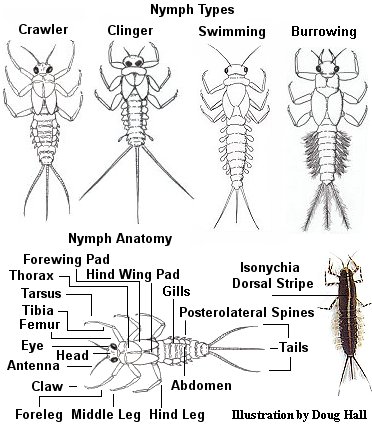
Mayfly Nymph Genus Identification

Although more in-depth study is needed to identify the nymphs species. A fairly accurate -educated guess- of the nymph genus can be made by following these general identification keys.
The most important clue could be the nymph type. Mayfly nymphs fall into one of four categories swimming, clingers, crawlers, and burrowing. Clingers have flat wide bodies and strong legs used to grasp rocks in fast currents. Crawlers have stout bodies and strong legs for crawling in medium to fast water. Swimming nymphs have weak feeble legs, and a long abdomens that wiggle up and down as they swim through the water. Burrowing nymphs have long bodies with short legs that have large claws for digging into silt, and debris on the steams bottom. These nymphs make their home in the slower silt, or sandy bottomed sections of the stream, some can be found in riffles where the current has deposited decomposed leaves and other debris.

Crawlers
Ephemerella
Size in millimeters 5 to 12.
Type, crawler.
Three fringed tails.
Small gills on the abdomens dorsal side.
Large posterolateral spines.
Attenella
Size in millimeters 6 to 8.
Type, crawler.
Three tails.
Small gills on the abdomens dorsal side.
Large posterolateral spines.
Drunella
Size in millimeters 5 to 12.
Type, crawler.
Three tails.
Small gills on the abdomens dorsal side.
Large posterolateral spines.
Femur longer, and wider than those of Ephemerella.
Serratella
Size in millimeters 3 to 4.
Type, crawler.
Three tails.
Small gills on the abdomens dorsal side.
Paraleptophlebia
Size in millimeters 5 to 6.
Type, crawler.
Three equal length tails.
Fine hair like forked gills.
Leptophlebia
Size in millimeters 10 to 13.
Type, crawler.
Three tails.
Long thin forked gills on abdominal segment 1, wide double gills on segments 2 to 7.
Tricorythodes
Size in millimeters 3 to 4.
Type, crawler.
Three tails.
Triangle shaped gills on abdominal segment 2.
Clingers
Epeorus
Size in millimeters 8 to 12.
Type, clinger.
Two tails.
Heart shaped mark on femur.
Large plate like gills.
Stenonema
Size in millimeters 9 to 16.
Type, clinger.
Three stiff wide spread tails.
Rounded gills or truncate on abdominal segments 1 to 6, thread like gills on segment 7.
Dark bands on femur.
Stenacron
Size in millimeters 8 to 11.
Type, clinger.
Three long tails spread wide.
Pointed gills on abdominal segments 1 to 6, thread like gills on segment 7.
Dark bands on femur.
Leucrocuta
Size in millimeters 5 to 6.
Type, clinger.
Three tails.
Plate like gills.
Swimmers
Baetis
Size in millimeters 5 to 7.
Type, swimming.
Three tails, middle tail shorter than the two outer tails.
Oval plate like gills.
Acentrella
Size in millimeters 3 to 4.
Type, swimming.
Three tails.
Oval plate like gills.
Isonychia
Size in millimeters 10 to 16.
Type, swimming.
Three fringed tails.
Displays a white or cream colored dorsal stripe.
Fringed forelegs.
Single marabou like gills.
Burrowing
Ephemera
Size in millimeters 10 to 30.
Type, burrowing.
Three fringed tails.
Displays tusks that are turned out.
Front of head has horn like notches.
Anthopotamus
Size in millimeters 13 to 16.
Type, burrowing.
Three fringed tails.
Double marabou like gills on abdominal segments 2 to 7.
Pincher like tusks.
Head is rounded with no horn like notches.
Ephoron
Size in millimeters 13 to 14.
Type, burrowing.
Three fringed tails.
Marabou like gills on the abdomens dorsal side.
Pincher like tusks that touch at the points.
Front of head has a cone shaped extension.
Short femur on the forelegs, and middle legs.
Hexagenia
Size in millimeters 16 to 35.
Type, burrowing.
Three fringed tails.
Marabou like gills on the abdomens dorsal side.
Tusks are cuved in and up.
Front of head has a rounded extension.